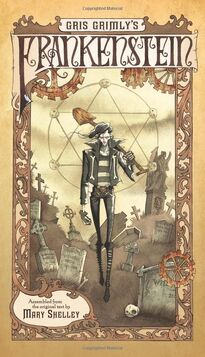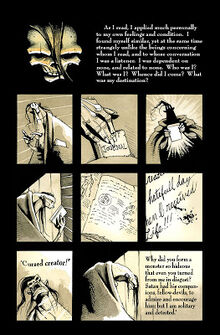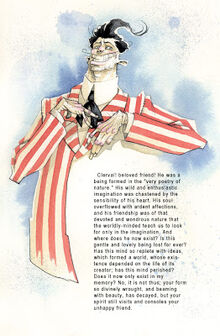
Gris Grimly’s Frankenstein is a graphic novel by Gris Grimly. Grimly uses captivating illustrations paired with Mary Shelley’s original text to create an experience that maintains the spirit of the original with unique visual component. Grimly’s vision of Frankenstein is part Steampunk, part Gothic. Grimly's novel received critical praise, sparked new interest for a younger audience, and received 4.5 stars on Amazon. The magic of Grimly's text lies in his ability to find terrible beauty in Frankenstein's world and bring it to life.
Summary
Grimly’s vision of Frankenstein is part Steampunk part Gothic. He includes little details like skull centered flowers and cross bone butterflies mixed with innovative machinery such as guns and cars, creating a distinctive world for Frankenstein. The novel follows the pattern of the original text quite closely, however Grimly follows no consistent formula in creating his pages.
The graphic novel mirrors the novel's three volumes. Grimly begins with several pages of beautiful letters written by R. Walton to his sister back home. His decision to begin the graphic novel this way is bold as it means the first few pages are very text heavy. However for those who love the frame narrative from the original text including these letters is a real treat. This portion of the original is seldom seen in adaptations. Grimly takes great care to make the pages striking as well as authentic. The things that Grimly includes by staying close to the original narrative add layers to the confusing man he becomes. While the way his parents came to be married may seem inconsequential it is another instance where a woman relies on a man which recurs later. This is perhaps one of earlier stories of death that Frankenstein heard as a child. Grimly also includes Frankenstein’s frustration at his father’s brushing off of the texts he finds interesting. This one moment is the catalyst that begins Frankenstein’s journey into the science of life and death. For his father it is clear he only means to inform Frankenstein of the truth, but for Frankenstein he sees his father’s flippancy as ignorance and becomes all the more intense. Grimly’s drawing of Frankenstein as he hardens at his father’s words is the first instance of a grim frown on Frankenstein’s face. These many little details bind together Frankenstein’s history in science and death. Grimly has his own style for drawing people which fits well with the dark and ominous aspects of the story. He takes great care to draw Justine in a very traditional way. The panel featuring her sleeping form, as The Creature frames her for the murder of William, is perhaps the most classically beautiful portrait of the entire novel. Volume One ends with the execution of Justine.

Volume Two focuses primarily on the Creature. Grimly gives The Creature plenty of space to share his journey. He begins this part of the story, told from The Creature’s prospective, with six words. Throughout the following pages the panels depict The Creature’s early education, beginning in stark black and white. During these pages The Creature is almost child-like as he learns what to eat, how to stay warm, and how cruel humans can be. Perhaps the most touching sections come during his time observing the De Lacey family. The panels, which are now pale sepia, illustrate The Creature’s education on family, language, and community. The panels become rich sepia with some color as The Creature learns to read. Grimly begins to illustrate The Creature with more detail as he learns of his own making and his creators feelings about him. The end of this section shows a very different Creature as he finishes his tale with the failed attempt at interaction with the De Lacey’s.
Volume Three contains the few bright moments left for Frankenstein before The Creature takes it all away. This section holds the best and worst of Frankenstein's life. Here color is scarce, but plays an important role. One of the most colorful and pure image is a full page of Cherval's grinning form. His bright red coat is the only bright color used. This stands in contrast to his version of how Frankenstein is able to harness life with this green liquid used to connect the monster together. His treatment of The Creature and hid would-be-bride depict a distinct similarity to human form while maintaining the “other” qualities as well. Grimly wraps up his novel by intertwining Walton’s letters with panels in the last few pages. Here we see the end of Frankenstein and experience the affects his death has on The Creature. The last image of The Creature carrying Frankenstein out into the icy abyss is haunting.
Major Themes
Friendship

Frankenstein is a key component of life. While we can survive alone, that life is hard to lead. Community and the friendships it brings give us a support system, a moral compass, and a way to share joy. Grimly takes great care to highlight that Frankenstein sees the world brightest through friendship. Frankenstein is happiest when enjoying free time with Cherval. Grimly uses the contrast of Frankenstein’s dark days in the lab against Cherval’s bright easygoing personality to express that seclusion is the root of Frankenstein’s evil. Repeatedly Frankenstein is drained of life, and then brought back to society by Cherval. The Creature goes to great pains to destroy all of Frankenstein's community leaving with nothing else but the pursuit of The Creature.
Ambition
Including the frame enables the reader to see the ambition theme play out for Frankenstein and Walton. This story is a cautionary tale about discovery and the price we pay for having our name remembered. Walton is determined beyond reason to reach the North Pole, much in the same way Frankenstein was committed to discovering the mystery of death. Even on his death bed, and after all he has lost, Frankenstein still admonishes the men on Walton’s ship for putting their lives above discovery. Here we see how little Frankenstein has really learned. Of course no one wins in the end, except Walton perhaps who we know returns home safely.
Revenge
The Creatures side of the story is very much rooted in the impact his abandonment has on him. The Creature experiences the unpredictable nature of life without a guide which leads him to view his creator as the one responsible not only for his lonely life, but his very existence. This creates a circle of destruction that eventually ends both creator.
Significance
Grimly masters the marriage of old and new through his use of original text and unique illustrations. Perhaps the biggest marker of a great adaptation is how well the spirit of the story is captured and re-presented to the audience. From reading Grimly’s novel we revisit themes of community, knowledge, and solitude. He gives form to the experiences of The Creature aiding in our understanding of his harsh entry into the world. Somehow he creates a Frankenstein that is monstrous and yet not devoid of some sympathies. Most notably he gives each sub character a chance to be focused on as The Creature wreaks havoc on whole Frankenstein family. Through very intricate, yet unassuming drawings Grimly creates a new face for the tale, while telling the same old story.
Grimly makes several artistic choices that draw connections through color choices and page set up. The majority of the pages have an off white background. Then suddenly as Frankenstein addresses his mother’s death the page is almost entirely black. He uses the black backdrop throughout the novel during various dark times. For instance Frankenstein’s life turns more sinister as he begins robbing graves; dark pages are also used when he is left alone to long in his lab. The way various second string characters are treated refer to some important themes also. Elizabeth for instance is not featured very often in the novel, and yet her character remains central to the plot. You can see her change along with Frankenstein as she watches her playmate and love spiral out of control. She begins very beautiful and well put together, but as Frankenstein’s life unravels her appearance becomes more severe from a thinner frame to a less maintained appearance. It is clear that Grimly uses facial features to highlight moods or motives of the character, even changing the way they look as the character changes. In this way you can follow the story of each character just from the changes to their features. The Creature’s appearance continues to change until his face is almost skeletal at the end.
Grimly also enojoys bringing his fans along with him for the ride as he shares sketches and almost finished pages during the creation process on his blog.
Reception
Grimly's graphic novel received praise for it's ability to blend Shelley's text into a truly unique creation. Avid Frankenstein fans enjoy experiencing the story in a new way. His novel also encourages younger readers to take another look at an old classic.
“Grimly’s haunting illustrations dramatically show the range of human emotion connected with Frankenstein and his monster-rage, despair, hurt, lament, and even joy and excitement. Though often dark, Grimly’s version has a whimsical quality that will draw teens in and allow them to better access this classic novel.” —Voice of Youth Advocates (VOYA)
Contribution made by Shari Oliver
